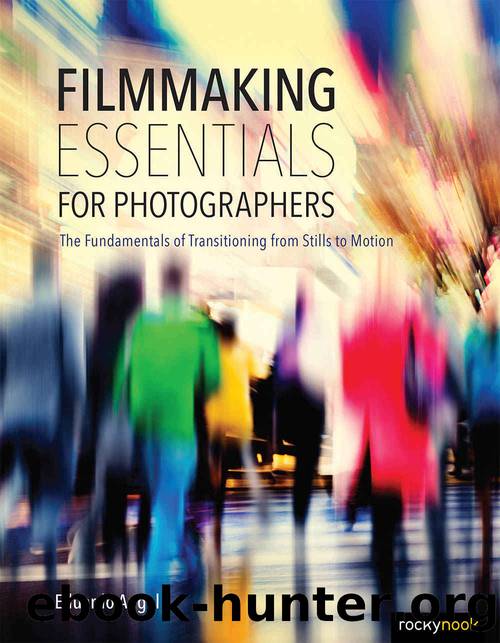Filmmaking Essentials for Photographers: The Fundamental Principles of Transitioning from Stills to Motion by Eduardo Angel

Author:Eduardo Angel
Language: eng
Format: azw3
Publisher: Rocky Nook
Published: 2016-12-21T08:00:00+00:00
THE EAR, NOT THE EYE, LEADS THE SENSES
One of the things I like the most from cinema is how music can be used as an additional layer, color, or even a character. Imagine an epic medieval battle. Would you use frantic drums and trumpets or a calming waterfall as your sound? And now imagine a romantic scene at its peak, seconds before the guy drops to his knees and asks the girl to marry him. Would you attempt to enhance the scene with a heavy-metal song? I’m sure you get my point. Here are some wonderful examples.
Hong Kong independent director Wong Kar-wai famously stated that “musicians have a musical language and filmmakers have a visual language, and most of the time we can’t understand each other.” That might be true, but Kar-wai has demonstrated that he can also speak the musical language through his masterful use of music from a slightly different time than the story’s time period to make the story more ambiguous.
A great example of his approach is the soundtrack for In the Mood for Love. The story takes place in 1962, but we listen to “Aquellos Ojos Verdes,” composed by Nilo Menendez and Adolfo Utrera in 1929, and “Quizas, Quizas, Quizas,” composed by Joe Davis and Osvaldo Farrés in 1947, with both songs recorded by Nat King Cole in 1958.
To better understand Wong Kar-wai’s compositional and directorial choices, I recut In the Mood for Love into a single 18-minute clip while trying to maintain the integrity of the story. You can watch the clip here: http://bit.ly/Mood4Love.
Among the many lessons learned from this exercise, perhaps the most valuable was the timing between cuts. Unlike with most contemporary films, In the Mood for Love holds each shot much longer, giving the viewer a fascinating sensation of anxiety and urgency.
Many directors, including Martin Scorsese, frequently use music on the set to achieve a specific mood. Scorsese goes as far as using a specific song to develop a shooting rhythm or to explain the speed he wants for certain camera moves.
In Wall Street, Oliver Stone very successfully relied on handheld camera movement to convey a sense of instability and chose electronic music featuring David Byrne and Brian Eno to generate “an enduring musical dynamism of electronic sounds and engrained beats.”
Psycho is considered by many critics and film lovers to be Alfred Hitchcock’s best film. The now famous shower sequence was specifically planned by the director to have only the sound of the running water. The legendary composer Bernard Herrmann, who also scored Vertigo, Citizen Kane, and Taxi Driver, among others cinema classics, didn’t follow the director’s instructions and created the quintessential sound of terror using only the string section of an orchestra due to budgetary constraints. Hitchcock, after seeing the completed scene with Herrmann’s music, gave his nod of approval.
A modern-day Herrmann is Hans Zimmer, the composer behind the scores for Inception, Gladiator (one of the bestselling film score albums of all time), Black Rain, Rain Man, True Romance, The Lion
Download
This site does not store any files on its server. We only index and link to content provided by other sites. Please contact the content providers to delete copyright contents if any and email us, we'll remove relevant links or contents immediately.
Shoot Sexy by Ryan Armbrust(17138)
Portrait Mastery in Black & White: Learn the Signature Style of a Legendary Photographer by Tim Kelly(16483)
Adobe Camera Raw For Digital Photographers Only by Rob Sheppard(16383)
Photographically Speaking: A Deeper Look at Creating Stronger Images (Eva Spring's Library) by David duChemin(16158)
Bombshells: Glamour Girls of a Lifetime by Sullivan Steve(13107)
Art Nude Photography Explained: How to Photograph and Understand Great Art Nude Images by Simon Walden(12346)
Perfect Rhythm by Jae(4621)
Pillow Thoughts by Courtney Peppernell(3392)
The Book of Joy by Dalai Lama(3216)
Good by S. Walden(2912)
The Pixar Touch by David A. Price(2739)
Fantastic Beasts: The Crimes of Grindelwald by J. K. Rowling(2542)
A Dictionary of Sociology by Unknown(2516)
Humans of New York by Brandon Stanton(2378)
Read This If You Want to Take Great Photographs by Carroll Henry(2300)
Stacked Decks by The Rotenberg Collection(2270)
On Photography by Susan Sontag(2128)
Photographic Guide to the Birds of Indonesia by Strange Morten;(2087)
Insomniac City by Bill Hayes(2082)
